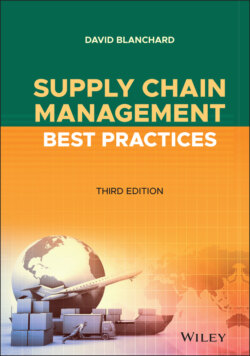Читать книгу Supply Chain Management Best Practices - David Blanchard - Страница 21
Food and Beverage: Cutting Out the Middleman
ОглавлениеAccording to an industry study, more than 80% of the manufacturers and retailers in the United States are outsourcing at least some of their logistics operations to a third-party logistics provider (3PL).9 Be that as it may, dairy producer Land O'Lakes believes it has gained a significant savings on its freight costs by bucking the 3PL trend. As a result of bringing its logistics operations back in-house as well as participating in a collaborative transportation network, the nation's leading butter producer has been able to shave as much as 20% off its annual freight costs.
Those savings came in several ways. For one thing, Land O'Lakes no longer had to pay administration fees to a 3PL, which were running as much as $20 per load. Considering that the company might ship out 30,000 truckloads per year, that adds up to a hefty savings right there. Also, by eliminating the 3PL from the equation, Land O'Lakes was able to negotiate its own transportation rates with the motor carriers—in effect, cutting out the middleman—and in the process reclaimed logistics as one of its core competencies.10
Land O'Lakes' use of a web-based collaborative network also enables it and other participants—manufacturers, retailers, and carriers—to plan, execute, and settle their inbound and outbound truckload and less-than-truckload (LTL) transportation. That allows the company to be more proactive about getting the level of customer service it needs from the trucking companies. It wasn't so much that the 3PL wasn't equal to the task, but Land O'Lakes preferred to execute on its own freight strategy, which could happen only by bringing the transportation process back in-house.
The collaborative network it uses consolidates and updates information about routes, loads, and schedules from all of the members' in-house logistics scheduling systems. One advantage to using a collaborative network is the ability to set up tours—sharing truckload capacity with other network participants. For instance, Land O'Lakes is involved with another consumer goods company on a backhaul pilot project. The two companies are partnering to share loads with the goal of reducing empty miles—those periods of time when a truck is traveling from one destination to another without carrying any freight. In the packaged foods industry, trucks are often empty as much as 25% of the time spent moving between stops. If, for instance, Land O'Lakes has several truckloads of refrigerated freight per week going from Chicago to Philadelphia, and another member of the network community has a similar number of weekly truckloads going from Philadelphia to Chicago, then both companies stand to benefit by sharing the available capacity and eliminating empty “deadhead” miles.
There is some risk involved in such a partnership, admits Yone Dewberry, Land O'Lakes' chief supply chain officer. “If we accept a return shipment from the other shipper, there is the chance that delays associated with that shipment could lead to that truck not being available when it is needed.” The key to making such a partnership work for all parties, Dewberry says, is real-time shipment visibility.11
Land O'Lakes is also working with Uber Freight on a project utilizing freight-hailing technology to match suppliers with available trucks using an app similar to the one passengers use to hail taxi-like car rides from parent company Uber. For a single lane between the Texas cities of Fort Worth and Nacogdoches (a distance of roughly two hundred miles one-way), Land O'Lakes posts all available loads to the Uber Freight app, where carriers and drivers can see all the details of the freight and can book loads directly from their phones or computers. This type of lane optimization is saving the company both time and money.12
